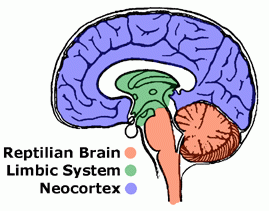August 3, 2016
About the author : Ben Martin is a research and business development associate at Thera Rising Intenational. He also delivers seminars and oversees digital development.
Last time, we talked about the mind/brain distinction, defined neuroplasticity, and wrapped up with a quick exercise on taking in the good. We’ll need to keep these basics in mind as we continue with this series.
Today, we’re going to be talking about different layers of the human brain. First, there’s the “lizard brain” or “reptile brain.” In more formal language, this is called the medulla, and it’s the smallest layer. In evolutionary terms it’s the oldest part of our brain. It’s the foundation, both physically and functionally. Just think brain stem.
After that, there’s the limbic system, which is often called the “mouse brain” or “mammalian brain.” It sits on top of the medulla.
Finally, there’s the “monkey brain,” or the neocortex. This is a distinctly primate piece of hardware, and it’s the lumpy gray stuff we usually think of when we think of the brain. It’s both the newest and biggest layer.

It can be tempting to treat the medulla, the least developed part of the brain, as inferior. But in fact, each part of the brain plays a vital part in keeping us going.
However, the small, inflexible, ancient lizard brain isn’t well suited to most of our modern day-to-day activities. Think about how dense we can be when we get mad. That happens because when we’re flooded with adrenaline, the lizard brain hijacks our higher brain functions. It goes to show how differently we think and act depending on which part of the brain we’re activating. (For more information, see this post on the lizard brain.)
Understanding the functions of each part of the brain is central to the field of neuroplasticity. For example, as you move “back in time” from the cortex to the medulla, neuroplasticity decreases. In Rick Hanson’s words, “the lizard takes a lot of petting.”
If you’d like to read more about the different parts of the brain, Rick Hanson’s blog has an article on each.
Thanks for reading! Next time, we’ll get to the heart of the positive neuropsychology: the negativity bias. See you then!
 Ben Martin specializes in research and business development at Thera Rising. When he’s not out delivering seminars, he oversees client outreach and digital development.
Ben Martin specializes in research and business development at Thera Rising. When he’s not out delivering seminars, he oversees client outreach and digital development.
LinkedIn: Ben Martin
April 23, 2019
February 28, 2019
Comments are closed
[…] far in Brain Bytes, we’ve covered the basics of neuroplasticity, taking in the good, and the three brains: lizard, mammal, and primate. This week, we’re going to get to the very center of […]
[…] simple exercise counter something as powerful as the negativity bias? In a word, focus. Our anxious “lizard brain” is always on the lookout for everything that could possibly go wrong. That can be helpful (if […]